1. The Midnight Zoomies

One of the most common yet perplexing behaviors that cats exhibit is the midnight zoomies. At some point during the night, your cat may suddenly dash around the house, leaping over furniture and running full speed through rooms. This can happen at 2 a.m. or even later, often waking owners from their sleep. Why would a cat choose to expend so much energy when the world is asleep?
The root of this behavior is tied to your cat’s natural instincts as a crepuscular animal, meaning they are most active during the twilight hours—dawn and dusk, according to PetMD. Wild cats are typically hunters during these low-light periods, and this natural rhythm persists in domesticated cats. While you may be fast asleep, your cat is biologically primed to engage in a hunt-like play session. If your cat hasn’t gotten enough physical or mental stimulation during the day, it can lead to these nocturnal bursts of energy. The zoomies may also be a way to burn off pent-up energy from inactivity. Though it may seem disruptive, this behavior is just part of being a cat.
2. The Kneading

Another peculiar behavior that many cat owners are familiar with is kneeling. If you’ve seen your cat press its paws alternately against your lap, a blanket, or even a piece of furniture, you’ve witnessed kneading in action. This behavior can appear adorable, but it’s also a deeply ingrained ritual that stems from their kittenhood.
Kittens knead their mother’s belly to stimulate milk production, and this behavior is retained into adulthood as a form of comfort, according to PetMD. When your adult cat kneads, it’s essentially regressing to a time when it felt safe, nurtured, and content. Kneading is often accompanied by purring, which indicates that your cat feels calm and relaxed. It’s also a way for cats to mark their territory. The pads of their paws contain scent glands, so when they kiss, they are leaving their unique scent behind, marking you or the environment as “theirs.” While it may seem like a simple behavior, kneading is a comforting ritual that helps your cat bond with you, marking you as a trusted companion.
3. The Head-Butt
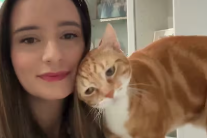
One of the most endearing behaviors cats exhibit is the head-butt, or “bunting,” where a cat nudges or butts its head against you or even objects like furniture or walls. According to PetMD, while it might seem a bit odd, this behavior is actually a sign of affection and social bonding.
In the wild, cats have scent glands located around their faces and cheeks. When they bump or rub their heads against you, they’re marking you with their scent, essentially saying, “You’re part of my social group.” This is a behavior that cats use to show affection toward other members of their social group, whether that’s other cats or humans. By head-butting you, your cat is signaling trust and familiarity. It’s their way of saying, “I like you” and “You are part of my territory.” If your cat frequently gives you headbutts, it’s a clear indication that they feel safe, comfortable, and deeply connected to you.
4. The “Gift” of Prey

It’s not uncommon for cat owners to find that their feline has brought them “gifts”—whether it’s a dead mouse, bird, or other small creatures. While this may seem grotesque or unsettling, it’s actually a deeply ingrained instinct. According to Briannica, cats are natural hunters, and this behavior is an echo of their wild ancestors.
When your cat brings you a dead animal, they might be trying to share their “catch” with you, which in wild cat families is a sign of community and bonding. Mother cats often bring back prey to their kittens, teaching them how to hunt. In the case of domesticated cats, they may perceive you as part of their family or social group and want to present their “findings” to you. It’s their way of showing off their skills and contributing to the household. While it’s not the most pleasant gift to receive, this behavior highlights the importance of hunting and providing for one’s family, which is an instinct that remains intact even in housecats.
5. The “Catloaf” Position

If you’ve ever seen your cat sitting with its paws tucked neatly underneath its body, tail curled around itself, and a perfectly composed posture, you’ve witnessed the “catloaf” position. In this pose, your cat looks like a small loaf of bread, but this quirky position actually has a lot of meaning.
The catloaf position is a sign of a cat feeling comfortable and secure in its environment, according to Embassy Lakes. Cats often adopt this posture when they are relaxed but still on alert. While resting, they keep their limbs close to their body, allowing them to spring into action quickly if needed. Cats are natural predators, and even in their safest spaces, they are always prepared for potential threats. So, when your cat settles into the catloaf position, it’s their way of saying, “I feel safe here, but I’m still alert.” This behavior is often seen when they’re lounging but still keeping their eyes on their surroundings. It’s a blend of relaxation and readiness that is deeply embedded in their nature.
6. The “Chattering” Sound

If you’ve ever heard your cat make a strange, almost chattering or chirping noise, particularly when staring at birds, squirrels, or other prey animals outside, you may have wondered what’s going on. This behavior is known as “chattering,” and while it might sound like your cat is excited or frustrated, there are deeper instincts at play.
The chattering sound is often heard when cats are watching potential prey, like birds or small mammals, through a window. Scientists believe that this chattering could be an instinctual response to the excitement and frustration of seeing prey they can’t reach. The sound is similar to the “mimicking” noises that some wild predators make when trying to simulate the calls of their prey. In some cases, cats may also chatter to themselves as if they’re preparing to hunt. Some experts also suggest that the chattering may be an expression of “predatory aggression,” meaning the cat is exhibiting a form of pent-up energy or frustration that stems from their predatory instincts. So, while it may seem a bit odd, this chattering behavior is simply an echo of your cat’s natural hunting tendencies.
7. Scratching Everything in Sight
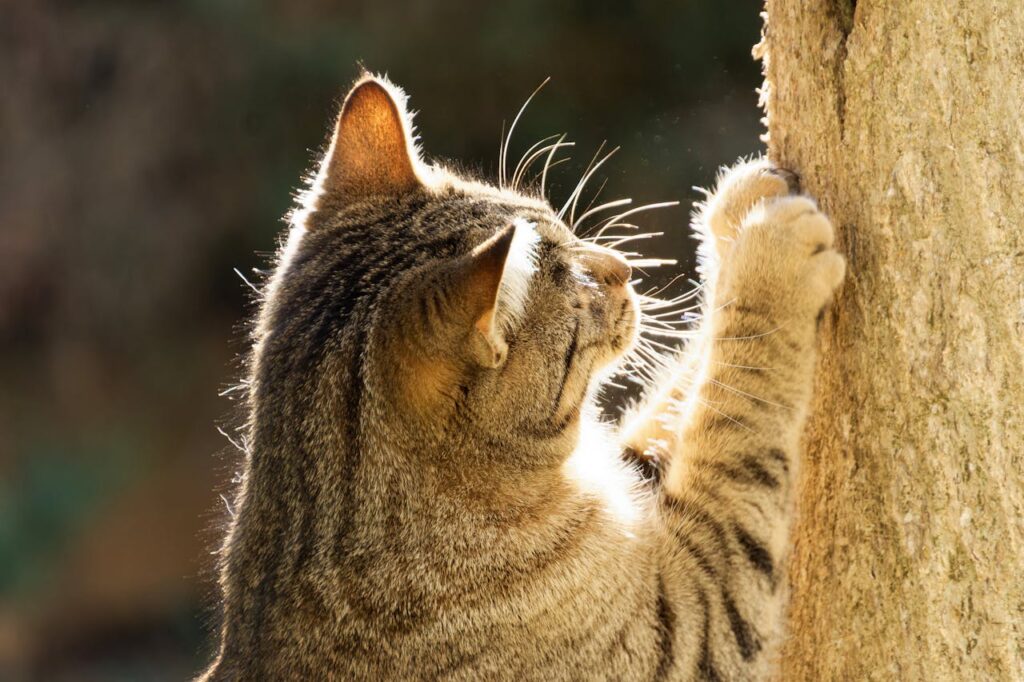
Cats scratch for several reasons, but one of the most bizarre and persistent behaviors they exhibit is their constant need to scratch everything in sight—your furniture, carpets, and even walls. At first glance, this may seem like an annoying habit, but it has multiple functions in a cat’s life that are deeply ingrained in their natural instincts.
First and foremost, scratching is a form of territorial marking. Cats have scent glands located in their paws, and when they scratch surfaces, they leave behind both a visual mark and their scent. This behavior is a way for cats to establish their territory, letting other animals know that they’ve claimed the space as their own. Scratching also serves as a way for cats to maintain their claws. The physical action of scratching helps to shed the outer layers of their claws, keeping them sharp and healthy. Additionally, scratching is a form of stress relief, allowing cats to stretch their muscles and release pent-up energy. If your cat scratches everything, it’s not just a sign of naughty behavior—it’s a fundamental part of their natural need to communicate, maintain their body, and feel secure in their environment.
8. Sleeping in Peculiar Positions
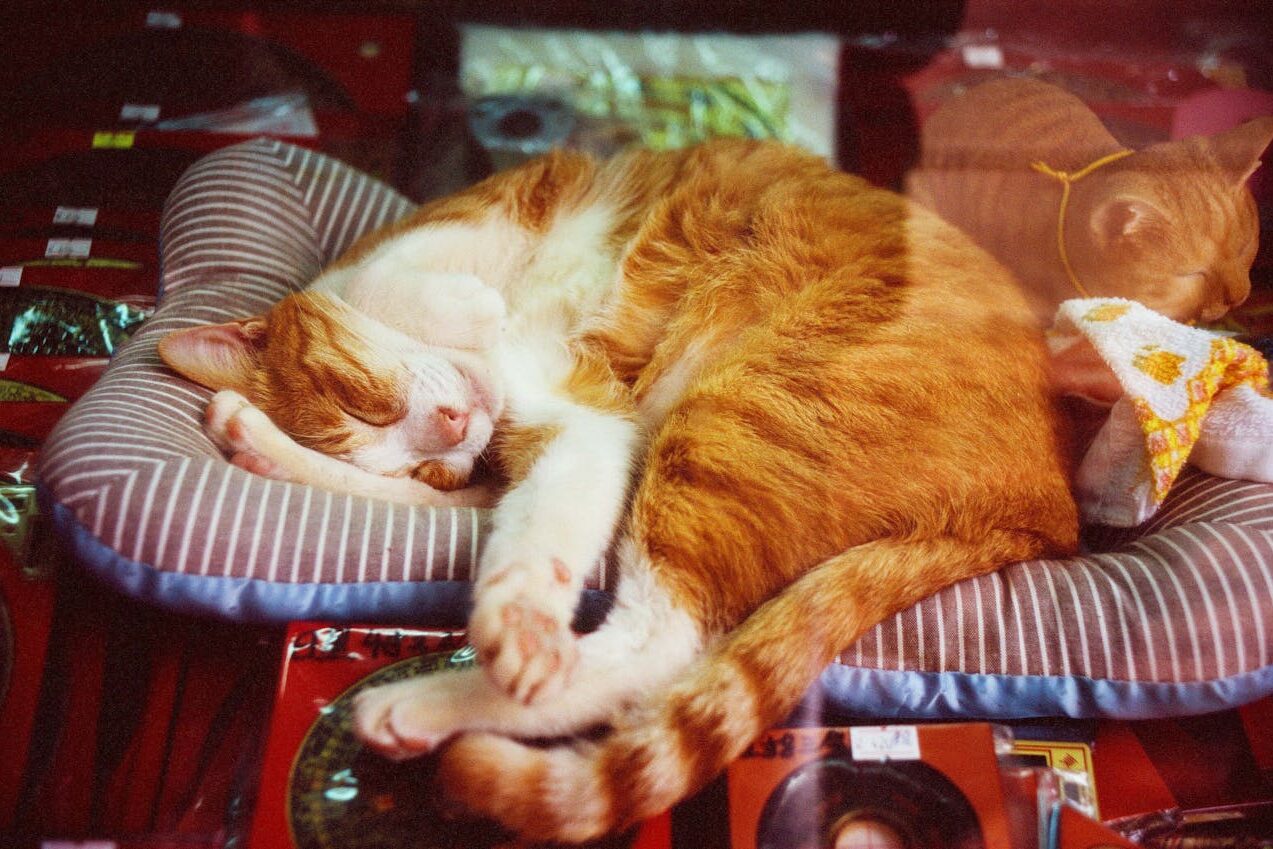
Cats are notorious for their ability to sleep in the most unusual positions, whether it’s sprawled out on their back with paws in the air or curled up in tight balls in tiny spaces. It can be a bit baffling at first, but these seemingly odd sleeping habits actually reveal a lot about your cat’s emotional state.
When a cat sleeps on its back with its belly exposed, it’s a sign of trust and comfort. In the wild, a cat is vulnerable in this position, so a domestic cat that sleeps belly-up is showing that it feels completely safe and relaxed in its environment. This position is usually reserved for moments when your cat feels very secure, whether that’s in your presence or in a familiar, safe spot in your home. Similarly, when your cat curls up in a tight ball, it’s often an instinctual response to seek warmth and security. In this position, they can conserve body heat and protect their vital organs. While it may seem odd to you, these sleeping behaviors are part of your cat’s complex emotional world, providing comfort, relaxation, and a sense of security.
9. Licking and Grooming You
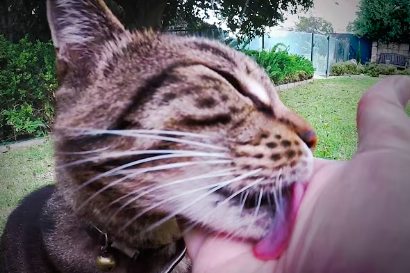
It might seem strange for a cat to lick you like it would another cat, but this behavior is actually a sign of affection and social bonding. In the wild, cats groom each other as part of their social interactions, and domestic cats retain this behavior, often transferring it to their human companions.
When your cat licks you, it’s a way for them to show that they trust you and consider you part of their social group. Cats have a natural instinct to groom, and when they lick you, they’re not just cleaning you—they’re reinforcing their bond with you. It’s also a sign that they feel comfortable and safe in your presence. Some cats may even groom you as a way of “caring” for you, just as they would groom a fellow cat in their family. This grooming behavior, while perhaps a little odd, is an important aspect of how cats interact with and show affection toward those they trust. It’s a beautiful reminder that your cat sees you as part of their family.
10. The Cat “Grin”
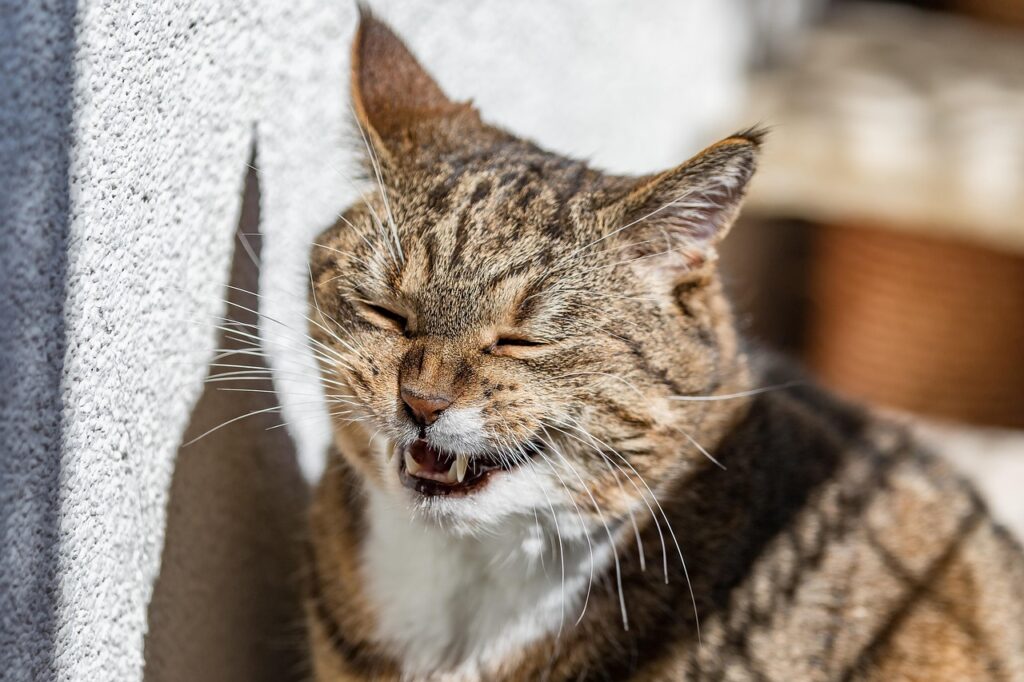
Have you ever seen your cat “grin,” with its mouth slightly open, showing its teeth? At first glance, this may appear to be a sign of happiness or contentment, but it can actually mean something very different. This “grin” is often a reaction to certain smells or stimuli, particularly ones related to pheromones.
The cat grin is a response to something called the “Flehmen response,” which is an involuntary behavior that occurs when a cat inhales certain scents, especially ones that are related to mating or other strong pheromonal signals. The open mouth and wrinkled face are simply a way for the cat to better analyze and process the scents it’s receiving. While the expression may look like a grin, it’s actually a physiological reaction rather than an emotional one. So, next time your cat makes this expression, rest assured it’s not smiling at you—it’s simply sniffing the air and analyzing its environment in the only way it knows how.
11. The Obsession with Boxes

If you’ve ever left an empty box on the floor only to find your cat immediately sitting inside it, you’re not alone. Cats have an undeniable obsession with boxes, whether they’re big, small, or barely large enough to fit in. This strange behavior is rooted in both instinct and comfort. In the wild, cats seek enclosed spaces to hide from predators and ambush prey, and a box provides that same sense of security. The confined space helps them feel protected from potential threats, making it a perfect retreat for relaxation or sleep. Even if your cat has no real dangers to avoid, the psychological comfort of being inside a box triggers a deep-seated survival instinct that makes them feel at ease.
Beyond security, cardboard boxes provide warmth, which is another reason cats gravitate toward them. The insulating properties of cardboard help retain body heat, keeping your cat cozy and comfortable. Additionally, the texture of cardboard satisfies a cat’s need to scratch and bite, making it an all-in-one playground. Some experts even believe that boxes help reduce stress in cats, giving them a safe space when they feel overwhelmed. If you want to keep your cat happy, don’t be in a rush to throw away your next Amazon package—your furry friend will likely claim it as their new favorite spot before you even get a chance.
12. The Tail Twitch

If you’ve ever watched your cat’s tail twitch or flick rapidly, you may have wondered whether it’s a sign of happiness, irritation, or something else entirely. Unlike dogs, whose wagging tails usually indicate excitement or friendliness, a cat’s tail movements can be much more complex and nuanced. A slow, rhythmic swish may mean your cat is deeply focused—perhaps stalking a toy or watching birds outside the window. However, a rapid, erratic flick or thump often signals annoyance, overstimulation, or even impending aggression. If you’re petting your cat and suddenly notice its tail lashing back and forth, it’s usually a warning sign that they’re reaching their tolerance limit and may swat or bite if you don’t back off.
The tail twitch can also be linked to bursts of excitement, especially when a cat is about to pounce. Kittens often display this behavior when they’re playing, and even older cats may exhibit a flicking tail when they’re feeling particularly playful. In some cases, though, excessive tail twitching can indicate discomfort or medical issues, such as pain from arthritis or nerve-related conditions. If your cat’s tail seems to be in constant motion, especially if paired with unusual vocalizations or behavioral changes, it may be worth consulting a vet to rule out any health concerns. Otherwise, watching your cat’s tail language can provide valuable insight into their mood—whether they’re feeling curious, irritated, or just gearing up for another round of zoomies.
13. Cat Purring
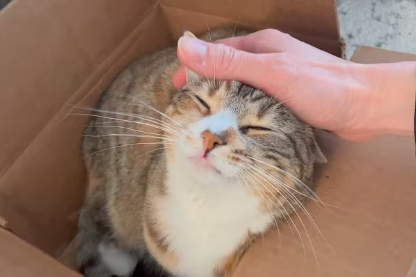
Purring is perhaps the most iconic cat behavior, and while many people associate it with contentment and happiness, the reasons behind it are more nuanced than you might think. At first glance, a purring cat might appear to be the picture of relaxation. However, purring is actually a multi-purpose behavior that serves several purposes beyond simply expressing pleasure.
While purring is often linked to contentment, cats also purr when they are frightened, anxious, or in pain. This is thought to be a self-soothing behavior, helping them to calm down during stressful situations. Interestingly, cats will also purr when they are in pain or feeling unwell, and it’s believed that purring may have a healing effect on their bodies. The low-frequency vibrations produced by a cat’s purring are believed to help with tissue regeneration and bone healing. So, while it’s common for cats to purr when they’re happy and relaxed, it can also be a signal that they’re in need of comfort or are experiencing discomfort. Understanding when and why your cat purrs can provide insight into their emotional and physical state, making it an important form of communication.
14. The Mysterious Slow Blink

If your cat has ever locked eyes with you and then slowly blinked, you might have wondered if they were trying to tell you something—or just feeling sleepy. In cat language, the slow blink is actually a sign of deep trust and affection. When a cat slowly closes and reopens its eyes in your presence, it’s a way of saying, “I feel safe with you.” In the wild, cats are always alert to danger, and closing their eyes even for a second could make them vulnerable. So, when your cat gives you a slow blink, it’s essentially letting you know that it doesn’t see you as a threat and is comfortable enough to lower its guard.
Many cat owners and behaviorists refer to this as a “cat kiss,” and you can even try returning the gesture. If you slowly blink back at your cat, you might find that they do it again, reinforcing the bond between you. Some cats even use slow blinks as a way of diffusing tension—if they sense uncertainty from a person or another animal, a slow blink can be a subtle signal that they mean no harm. If you’ve ever wanted a simple way to communicate love and reassurance to your cat, giving them a slow blink might just be the best way to do it.


